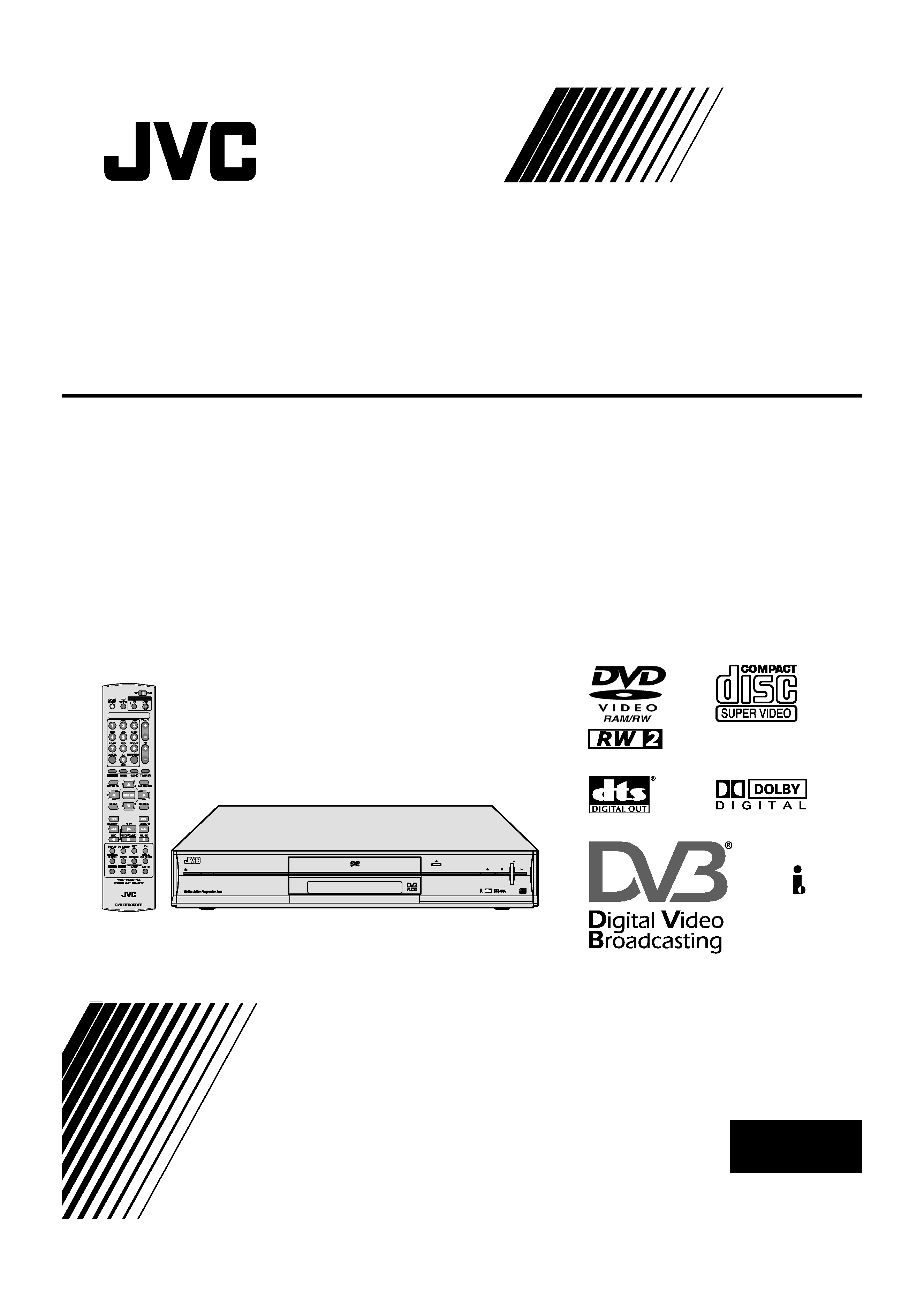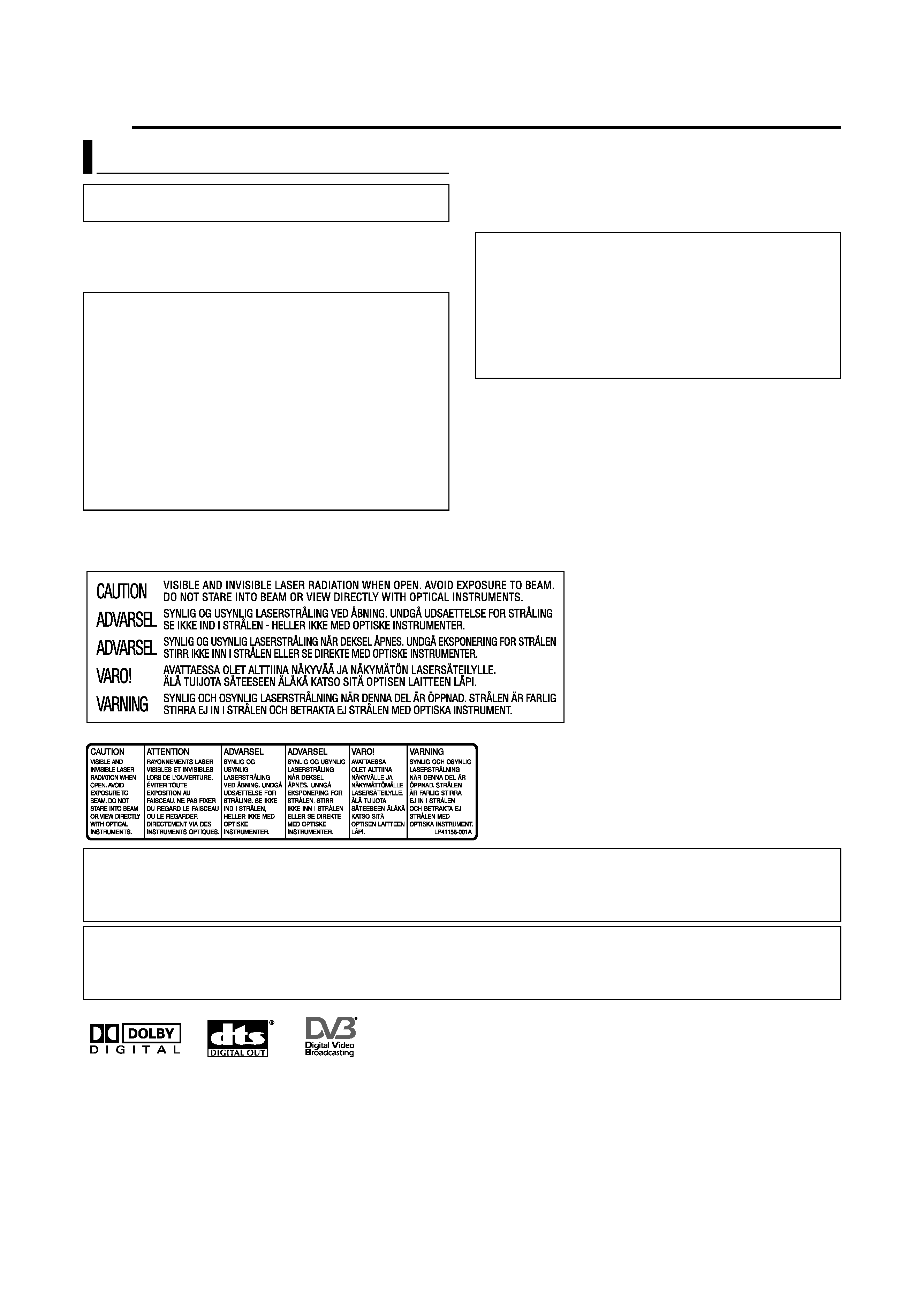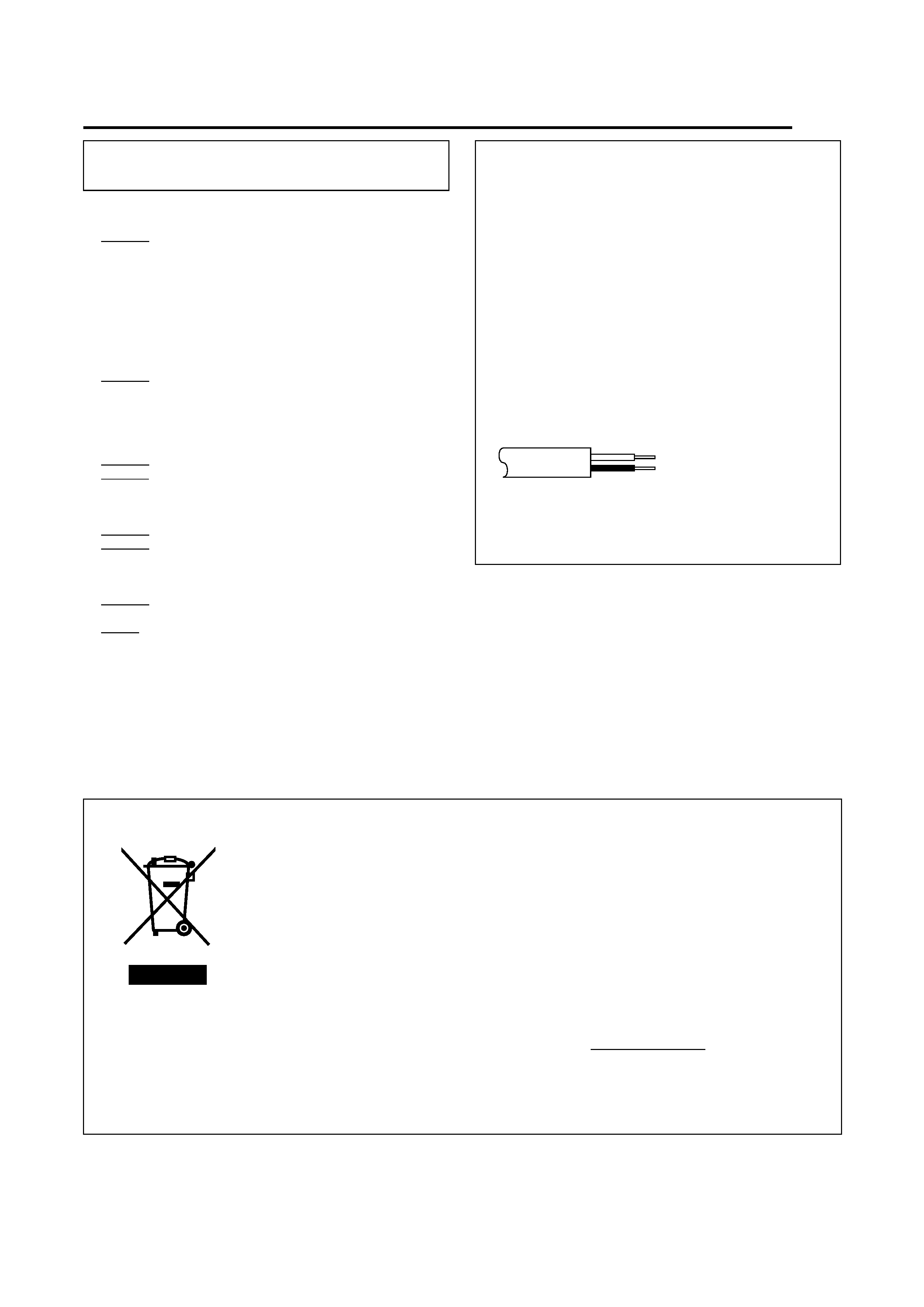
RAM/RW
STANDBY/ON
PR
PR Ð
PUSHÐOPEN
Trade Mark of the DVB Digital Video Broadcasting
Project (1991 to 1996) Number : 3546
LPT1045-001A
EN
DVD VIDEO RECORDER
INSTRUCTIONS
DR-M150SEK
M150SEK_00.book Page 1 Wednesday, June 15, 2005 4:04 PM

Filename [M150SEK_02Safety.fm]
Masterpage:Left0
2 EN
Page 2Wednesday, 15 June 2005 16:04
SAFETY FIRST
WARNING: DANGEROUS VOLTAGE INSIDE
WARNING: TO PREVENT FIRE OR SHOCK HAZARD,
DO NOT EXPOSE THIS UNIT TO RAIN OR
MOISTURE.
CLASS 1 LASER PRODUCT
REPRODUCTION OF LABELS
WARNING LABEL INSIDE OF THE UNIT
DISCLAIMER OF LIABILITY
JVC shall not be liable for any loss relating to the unit's failure to
properly record, store or playback any content (video, audio or
otherwise) for any reason whatsoever. Any applicable warranties
shall only cover replacement or repair of the effected unit, and shall
not apply to recovery or replacement of lost content.
Manufactured under licence from Dolby Laboratories. ADolbyB and double-D symbol are trademarks of Dolby Laboratories.
ADTSB and ADTS DIGITAL OUTB are trademarks of Digital Theater Systems, Inc.
DVB (Digital Video Broadcasting) is a registered trademark of Digital Video Broadcasting Project. The Digital Video Broadcasting system
is manufactured under license from Digital Video Broadcasting Project.
This product incorporates copyright protection technology that is protected by method claims of certain U.S. patents and other intellectual
property rights owned by Macrovision Corporation and other rights owners. Use of this copyright protection technology must be
authorized by Macrovision Corporation, and is intended for home and other limited viewing users only unless otherwise authorized by
Macrovision Corporation. Reverse engineering or disassembly is prohibited.
Safety Precautions
The rating plate and the safety caution are on the rear
of the unit.
CAUTION:
A UNIT IS A CLASS 1 LASER PRODUCT. HOWEVER THIS
UNIT USES A VISIBLE LASER BEAM WHICH COULD CAUSE
HAZARDOUS RADIATION EXPOSURE IF DIRECTED. BE SURE
TO OPERATE THE UNIT CORRECTLY AS INSTRUCTED.
WHEN THIS UNIT IS PLUGGED INTO THE WALL OUTLET,
DO NOT PLACE YOUR EYES CLOSE TO THE OPENING OF
THE DISC TRAY AND OTHER OPENINGS TO LOOK INTO
THE INSIDE OF THIS UNIT.
USE OF CONTROLS OR ADJUSTMENTS OR
PERFORMANCE OF PROCEDURES OTHER THAN THOSE
SPECIFIED HEREIN MAY RESULT IN HAZARDOUS
RADIATION EXPOSURE.
DO NOT OPEN COVERS AND DO NOT REPAIR YOURSELF.
REFER SERVICING TO QUALIFIED PERSONNEL.
OR
ATTENTION:
8
Using a mobile phone in the vicinity of the unit may cause
picture vibration on the TV screen or change the screen to a
blue back display.
8
If there is a power outage when using the unit, the recorded
data may be erased.
8
Recorded programmes and data cannot be restored once
the disc is damaged.
8
When discarding batteries, environmental problems must be
considered and the local rules or laws governing the
disposal of these batteries must be followed strictly.
IMPORTANT:
8
Please read the various precautions on page 2 - 4 before installing or operating the unit.
8
It should be noted that it may be unlawful to re-record pre-recorded tapes, DVDs, or discs without the consent of the owner of
copyright in the sound or video recording, broadcast or cable programme and in any literary, dramatic, musical, or artistic work
embodied therein.
CAUTION:
8
When you are not using the unit for a long period of time, it is recommended that you disconnect the power cord from the mains outlet.
8
Dangerous voltage inside. Refer internal servicing to qualified service personnel. To prevent electric shock or fire hazard, remove the
power cord from the mains outlet prior to connecting or disconnecting any signal lead or aerial.
8
The mains plug shall remain readily operable.
Trade Mark of the DVB Digital Video Broadcasting
Project (1991 to 1996) Number : 3546
M150SEK_00.book Page 2 Wednesday, June 15, 2005 4:04 PM

Masterpage:Right+
EN
3
Filename [M150SEK_02Safety.fm]
Page 3Wednesday, 15 June 2005 16:04
SAFETY FIRST
Failure to heed the following precautions may result in
damage to the unit, remote control or disc.
1. DO NOT place the unit ^
^ in an environment prone to extreme temperatures or
humidity.
^ in direct sunlight.
^ in a dusty environment.
^ in an environment where strong magnetic fields are
generated. In addition, do not place TVs or other appliances
which tend to generate strong magnetic fields on top of the
unit as it may cause picture disturbance.
^ on a surface that is unstable or subject to vibration.
2. DO NOT block the unit's ventilation openings or holes.
If the ventilation openings or holes are blocked by a newspaper
or cloth, etc., the heat may not be able to get out.
When installing the equipment, make sure there is a space
allowance of 10 cm or more on both sides, on top and at the
rear of the equipment.
3. DO NOT place heavy objects on the unit or remote control.
4. DO NOT place anything which might spill on top of the unit
or remote control.
(If water or liquid is allowed to enter this equipment, fire or
electric shock may be caused.)
5. DO NOT expose the apparatus to dripping or splashing.
6. DO NOT use this equipment in a bathroom or places with
water. Also DO NOT place any containers filled with water or
liquids (such as cosmetics or medicines, flower vases, potted
plants, cups, etc.) on top of this unit.
7. DO NOT place any naked flame sources, such as lighted
candles, on the apparatus.
8. AVOID violent shocks to the unit during transport.
MOISTURE CONDENSATION
Moisture in the air will condense on the unit when you move it from
a cold place to a warm place, or under extremely humid
conditions^just as water droplets form on the surface of a glass
filled with cold liquid. In conditions where condensation may occur,
disconnect the unit's power plug from the wall and keep it
disconnected for a few hours to let the moisture dry, then turn on
the unit.
The STANDBY/ON
A button does not completely shut off
mains power from the unit, but switches operating current on and
off.
ABB shows electrical power standby and ACB shows ON.
IMPORTANT
Connection to the mains supply in the United Kingdom.
DO NOT cut off the mains plug from this equipment.
If the plug fitted is not suitable for the power points in your home
or the cable is too short to reach a power point, then obtain a
proper safety approved extension lead/adapter or consult your
dealer.
In the unlikely event of the plug fuse failing be sure to
replace the fuse only with an identical approved type, as
originally fitted, and to replace the fuse cover. If the fuse
fails again consult your nearest JVC dealer.
If nonetheless the mains plug is cut off remove the fuse and
dispose of the plug immediately, to avoid a possible shock
hazard by inadvertent connection to the mains supply.
If this product is not supplied fitted with a mains plug then follow
the instructions given below:
DO NOT make any connection to the Larger Terminal coded E
or Green.
The wires in the mains lead are coloured in accordance with the
following code:
If these colours do not correspond with the terminal
identifications of your plug, connect as follows:
Blue wire to terminal coded N (Neutral) or coloured Black.
Brown wire to terminal coded L (Live) or coloured Red.
If in doubt -- consult a competent electrician.
Blue to N (Neutral) or Black
Brown to L (Live) or Red
Information for Users on Disposal of Old Equipment
ATTENTION:
This symbol is only valid
in the European Union.
[European Union]
This symbol indicates that the electrical and electronic equipment should not be disposed as general
household waste at its end-of-life. Instead, the product should be handed over to the applicable collection
point for the recycling of electrical and electronic equipment for proper treatment, recovery and recycling in
accordance with your national legislation.
By disposing of this product correctly, you will help to conserve natural resources and will help prevent
potential negative effects on the environment and human health which could otherwise be caused by
inappropriate waste handling of this product. For more information about collection point and recycling of this
product, please contact your local municipal office, your household waste disposal service or the shop where
you purchased the product.
Penalties may be applicable for incorrect disposal of this waste, in accordance with national legislation.
(Business users)
If you wish to dispose of this product, please visit our web page www.jvc-europe.com to obtain information
about the take-back of the product.
[Other Countries outside the European Union]
If you wish to dispose of this product, please do so in accordance with applicable national legislation or other
rules in your country for the treatment of old electrical and electronic equipment.
M150SEK_00.book Page 3 Wednesday, June 15, 2005 4:04 PM

Filename [M150SEK_02Safety.fm]
Masterpage:Left+
4 EN
Page 4Wednesday, 15 June 2005 16:04
SAFETY FIRST
This equipment has been designed and manufactured to meet international safety standards but, like any electrical equipment,
care must be taken if you are to obtain the best results and safety is to be assured.
DO read the operating instructions before you attempt to use the equipment.
DO ensure that all electrical connections (including the mains plug, extension leads and interconnections between pieces of equipment)
are properly made and in accordance with the manufacturer's instructions. Switch off and withdraw the mains plug when making or
changing connections.
DO consult your dealer if you are ever in doubt about the installation, operation or safety of your equipment.
DO be careful with glass panels or doors on equipment.
DON'T continue to operate the equipment if you are in any doubt about it working normally, or if it is damaged in any way^switch off,
withdraw the mains plug and consult your dealer.
DON'T remove any fixed cover as this may expose dangerous voltages.
DON'T leave equipment switched on when it is unattended unless it is specifically stated that it is designed for unattended operation or has
a standby mode. Switch off using the switch on the equipment and make sure that your family knows how to do this. Special
arrangements may need to be made for infirm or handicapped people.
DON'T use equipment such as personal stereos or radios so that you are distracted from the requirements of road safety. It is illegal to
watch television whilst driving.
DON'T listen to headphones at high volume, as such use can permanently damage your hearing.
DON'T obstruct the ventilation of the equipment, for example with curtains or soft furnishings. Overheating will cause damage and shorten
the life of the equipment.
DON'T use makeshift stands and NEVER fix legs with wood screws^to ensure complete safety always fit the manufacturer's approved
stand or legs with the fixings provided according to the instructions.
DON'T allow electrical equipment to be exposed to rain or moisture.
ABOVE ALL...
If your DR-M150 reports that no digital signals were found after auto-tuning, or if the number of channels found is fewer than
expected, this does not necessarily indicate a fault. Because of the nature of digital transmissions, there can be several external
causes for this.
The following information may help you determine the exact cause.
Digital transmissions are broadcast at much lower power and on different channels or different transmitters to analogue transmissions. This
may mean that you will require an aerial upgrade in order to receive them. Some smaller transmitters do not yet transmit digital signals at all.
To see if you are in an area covered by digital signals, use the online postcode checker at http://www.dtg.org.uk/consumer/coverage.html.
This will give a good indication of the conditions in your area. A more detailed version of the postcode checker, which shows more details of
the channels you can expect to receive in your area, is available at http://www.dtg.org.uk/retailer/coverage.html. Please note that these
postcode checkers give a good indication of what is available but, due to local conditions, they cannot be 100% accurate.
If you require an aerial upgrade to receive digital transmissions, you should first contact your dealer who should be able to advise on a suitable
aerial. If this is not practical, you should choose an aerial installer who is a member of the Confederation of Aerial Industries (CAI). All CAI
members conform to a code of practice. You can search for your local CAI registered installer at: http://www.cai.org.uk/asp/installer.asp
If you have a shared communal aerial system, this may be designed to receive only the analogue transmissions in your area. You should
check with your landlord or local housing authority to see if your aerial system can be upgraded to receive digital transmissions.
Please note that unless you are located very close to the transmitter, it is very unlikely that you will be able to receive digital transmissions
reliably with an indoor aerial.
If you have any other questions regarding the reception of digital transmissions, please call JVC Customer Services on 0870-330-5000.
Some Do's And Don'ts On The Safe Use Of Equipment
^ NEVER let anyone especially children push anything into holes, slots or any other opening in the case^this could result in a fatal
electrical shock;
^ NEVER guess or take chances with electrical equipment of any kind^it is better to be safe than sorry!
Information On Reception Of Digital Transmissions
M150SEK_00.book Page 4 Wednesday, June 15, 2005 4:04 PM

Masterpage:Right0
EN
5
Filename [M150SEK_03TOC.fm]
Page 5
June 15, 2005 4:04 pm
CONTENTS
SAFETY FIRST
2
Safety Precautions .........................................................................2
Some Do's And Don'ts On The Safe Use Of Equipment ...............4
Information On Reception Of Digital Transmissions ......................4
DISC INFORMATION
6
About Discs ....................................................................................6
INDEX
11
INSTALLING YOUR NEW UNIT
16
Basic Connection .........................................................................16
INITIAL SETTINGS
17
Auto Set Up..................................................................................17
Language .....................................................................................19
Monitor Set...................................................................................19
Setting DTV..................................................................................20
BASIC OPERATIONS ON DVD DECK
21
Basic Operation (TV)....................................................................21
Basic Playback.............................................................................22
Playback Features .......................................................................23
Live Memory Playback .................................................................27
Using The On-screen Bar ............................................................30
Basic Recording ...........................................................................34
Recording Features......................................................................35
TIMER RECORDING
37
EPG Timer Programming.............................................................37
Manual Timer Programming.........................................................38
On-Disc Timer Programming .......................................................39
Check, Cancel And Change Programmes ...................................41
Automatic Satellite Programme Recording ..................................42
NAVIGATION
43
Library Database Navigation........................................................43
Basic Operation Of Original Information ......................................44
Edit Original Information...............................................................46
Basic Operation Of Play List Information .....................................47
Edit Play List Information .............................................................48
Edit Library Information ................................................................51
Playback With MP3/JPEG Navigation..........................................52
EDITING
53
DV Dubbing ................................................................................. 53
Digital Audio Dubbing .................................................................. 54
Edit From A Camcorder ............................................................... 55
Edit To Or From Another Recorder ............................................. 56
Output/Input Set .......................................................................... 57
SYSTEM CONNECTIONS
59
Connecting To A Satellite Receiver ............................................. 59
Connecting To A Dolby Digital Decoder Or
An Amplifier With Built-in DTS .................................................. 59
SUBSIDIARY SETTINGS
60
Mode Set ..................................................................................... 60
Remote Control Functions ........................................................... 62
TV Multi-Brand Remote Control .................................................. 62
Tray Lock ..................................................................................... 63
Child Lock .................................................................................... 63
Scan Mode Set ............................................................................ 63
Tuner Set ..................................................................................... 64
Clock Set ..................................................................................... 66
Format A Disc .............................................................................. 67
Finalise A Disc ............................................................................. 68
TROUBLESHOOTING
69
APPENDIX
72
LIST OF TERMS
74
HOW TO USE THIS INSTRUCTION MANUAL
All major sections and subsections are listed in the Table Of Contents on page 5. Use this when searching for information on a specific
procedure or feature.
The Index on pages 11 - 13 illustrates the controls and connections on the front and rear panel, the front display panel and the remote
control.
The list of terms on page 74 lists frequently-used terms, and the number of the page on which they are used or explained in the manual.
The A mark signals a reference to another page for instructions or related information.
Operation buttons necessary for the various procedures are clearly indicated through the use of illustrations at the beginning of each
major section.
M150SEK_00.book Page 5 Wednesday, June 15, 2005 4:04 PM
